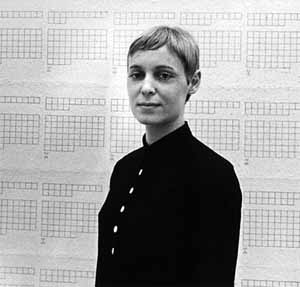Hanne Darboven facts for kids
Hanne Darboven (born April 29, 1941 – died March 9, 2009) was a German conceptual artist. She was famous for her very large art pieces. These often included many handwritten tables of numbers. Her work is sometimes called minimalist because it uses simple, repeated patterns.
Contents
About Hanne Darboven's Early Life and Training
Hanne Darboven was born in Munich, Germany, in 1941. She grew up in Rönneburg, a town near Hamburg. Her father was a successful businessman. His family's coffee brand, Darboven coffee, is still well-known in Germany.
Hanne first studied to be a pianist. Later, from 1962 to 1965, she studied art in Hamburg. In 1966, she moved to New York City. She lived there for two years, mostly working alone. After that, she moved back to her family home in Hamburg. She lived and worked there until she passed away in 2009. Her home was filled with a huge collection of interesting objects.
What Kind of Art Did Hanne Darboven Make?
In New York, Hanne met artists like Sol LeWitt and Joseph Kosuth. These artists were pioneers in Minimalism and Conceptual art. Conceptual art is all about the idea behind the artwork, more than the finished product. Minimalism uses very simple forms and patterns. Meeting these artists greatly influenced Hanne's own art.
Her Number Drawings: Konstruktionen
Soon after, Hanne started making drawings with lists of numbers. She used graph paper for these. The numbers came from complicated math problems. These problems were based on dates from the Gregorian calendar. For example, she might use the numbers from a specific day, month, and year.
Hanne called these simple number drawings Konstruktionen (which means "constructions"). She always wrote them by hand. Her artwork often showed rows of numbers going up or down. She also used U-shapes, grids, and lines. She used simple tools like pens, pencils, and typewriters. Like artist On Kawara, Hanne used her art to show time passing. She showed it as a continuous flow and also as a clear, organized system.
Adding Text and Objects to Her Art
In the 1970s, Hanne started adding words to her art. She saw her art as a form of writing. She would copy quotes or whole parts of texts from writers like Heinrich Heine. Sometimes she would turn these texts into patterns.
By 1978, Hanne also began to include pictures and objects. She used photos, postcards, and other items she found or bought. This allowed her to talk about historical events in her art. For example, her huge work called Vier Jahreszeiten (Four Seasons) (1981) used colorful postcards.
One of her biggest works is Cultural History 1880–1983 (1980–1983). This piece has 1,589 framed papers and 19 sculptures. It covers a very large area. It mixes cultural, social, and historical ideas with her own personal items. You can see postcards, pictures of movie stars, and references to World War I and II. It even includes diagrams for weaving textiles and covers from news magazines.
Another example is Sunrise / Sunset, New York, NYC, today (1984). This work has 385 drawings made with felt pen on graph paper. Each month starts with a drawing that includes a nostalgic postcard of New York. This first drawing is titled heute ("today"). The other days of the month are just numbered. The whole artwork shows a period of living and working. It also brings back old memories.
Turning Numbers into Music: Mathematical Music
In the 1980s, Hanne Darboven started to include music and photographs in her art. She created what she called "Mathematical Music." She would turn the numbers from her art into sounds. Each number was given a certain musical note. Then, long series of numbers became musical scores.
With help from others, Hanne turned these scores into music that could be played. Instruments like the organ, double bass, and string quartet performed her pieces. For example, the number 1 might be the note E, 2 could be F, and so on. If there was a two-digit number, it became an interval of two notes. Numbers with a zero became broken chords. Hanne said her number systems worked like a musical theme with variations.
Her piece Wende 80 (Turning point 80) (1980) was one of the first works that was also a musical score. This music was even put on 11 long-playing records.
Hanne Darboven's Legacy
In 2000, the Hanne Darboven Foundation was created. This foundation helps young artists, especially those who explore "space and time" in their art. The foundation also works to preserve Hanne Darboven's art. In 2012, they bought her old home in Rönneburg. This helps keep her work safe and lets the public see parts of her collection.
Where Hanne Darboven's Art Was Shown
Hanne Darboven's art has been shown in many exhibitions around the world. Her first solo show outside Germany was in Amsterdam in 1970. In 1978, she had her first exhibitions in the United States.
Her art has been featured in major art shows like Documenta in Kassel, Germany, and the Venice Biennale in Italy. At Documenta 11 in 2002, her work was a main part of the exhibition. More than 4,000 of her drawings were shown.
Her art is now represented by well-known galleries like Konrad Fischer Gallery and Sprüth Magers.
Awards Hanne Darboven Received
- 1985 Edwin-Scharff-Preis from the city of Hamburg
- 1994 Lichtwark-Preis from the city of Hamburg
- 1997 Member of the Akademie der Künste in Berlin
Public Collections Where Her Art Can Be Seen
Hanne Darboven's works are part of many important art collections around the world, including:
- Centre Georges Pompidou, Paris
- Dia:Beacon, Beacon, New York
- Hamburger Bahnhof, Berlin
- Hamburger Kunsthalle, Hamburg
- Museum für Moderne Kunst, Frankfurt am Main
- Stedelijk Museum voor Actuele Kunst (S.M.A.K.) in Ghent
See also
 In Spanish: Hanne Darboven para niños
In Spanish: Hanne Darboven para niños
- List of German women artists


